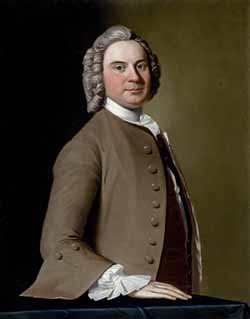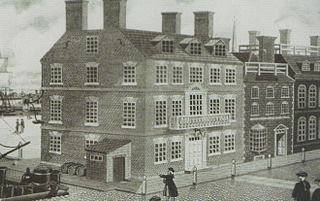“Weak in Arms Void of Virtue, Honor, or Honesty”
John Dupe, Esq; A Senator, a Man of Fortune, but not of his own acquiring---A Man of weak Capacity and like tainted Meat devoured by the Vermin about them, who drew his Money out of the Cashiers Hands Not trusting to the Loyalty of his Country Men—He is remarkably melancholy on his Loss of Lady Beaver.I think these are allusions to merchant John Hancock, lawyer James Otis, his wife Ruth Otis, most likely Dr. Thomas Young, and Boston town clerk William Cooper, respectively.
Poor Iammy, a Senator, who was the Leading Man in Politicks, but disappointed in Offices of Profit—He stands now ready arm’d to kill any Person who may be mader than himself.
Maria—His Wife, a worthy virtuous good Woman, comforting her Children, and bemoaning his unhappy Fate.
Thomas Wister, an Man weak in Arms Void of Virtue, Honor, or Honesty, whose compounds has poison’d his own Body and Soul, since that he has been finding out an Art to poison the Minds—Private Confessor to Admiral Renegado.
William Town, Regulating Clerk to the Parish—Procurer of Knights of the Post, and Secretary to Admiral Renegado, and Justice Gutts; also Secretary to the Caulkers Club, and chief Compiler of the Country Parish Resolves.
John Mein identified Hancock as “John Dupe” in his “Key to a certain Publication,” now at the Houghton Library, so that’s an easy one.
Back in October, Mein called Otis “Counsellor Muddlehead,” but by this time people recognized that he was mentally ill. Otis’s wife was indeed known as a Loyalist.
I’m guessing the references to “compounds” and “poison” were hints that “Thomas Wister” was a physician, hence the radical Dr. Young. This page never introduced “Admiral Renegado” at all despite these two allusions to that character. But the 5 Feb 1770 Boston Chronicle had used “Admiral Renegado” as another name for William Molineux, already introduced in the Nova Scotian item as “William the Knave.”
The paragraph on “William Town” contains several pointers to William Cooper, plus a reference to the “Caulkers Club” or caucus. This might be the first publication connecting that mysterious word for a political group to the profession of caulking, and it appears to be a joke.
The article offers no explanation of “Justice Gutts,” and I can’t find the Boston Chronicle using that name anywhere. Perhaps that was an alternate name for the next entry in the article: “Richard Glutton, Esq; a regulating Magistrate.” But I’m not sure who that’s meant to be.
TOMORROW: Mysteries and questions.


















